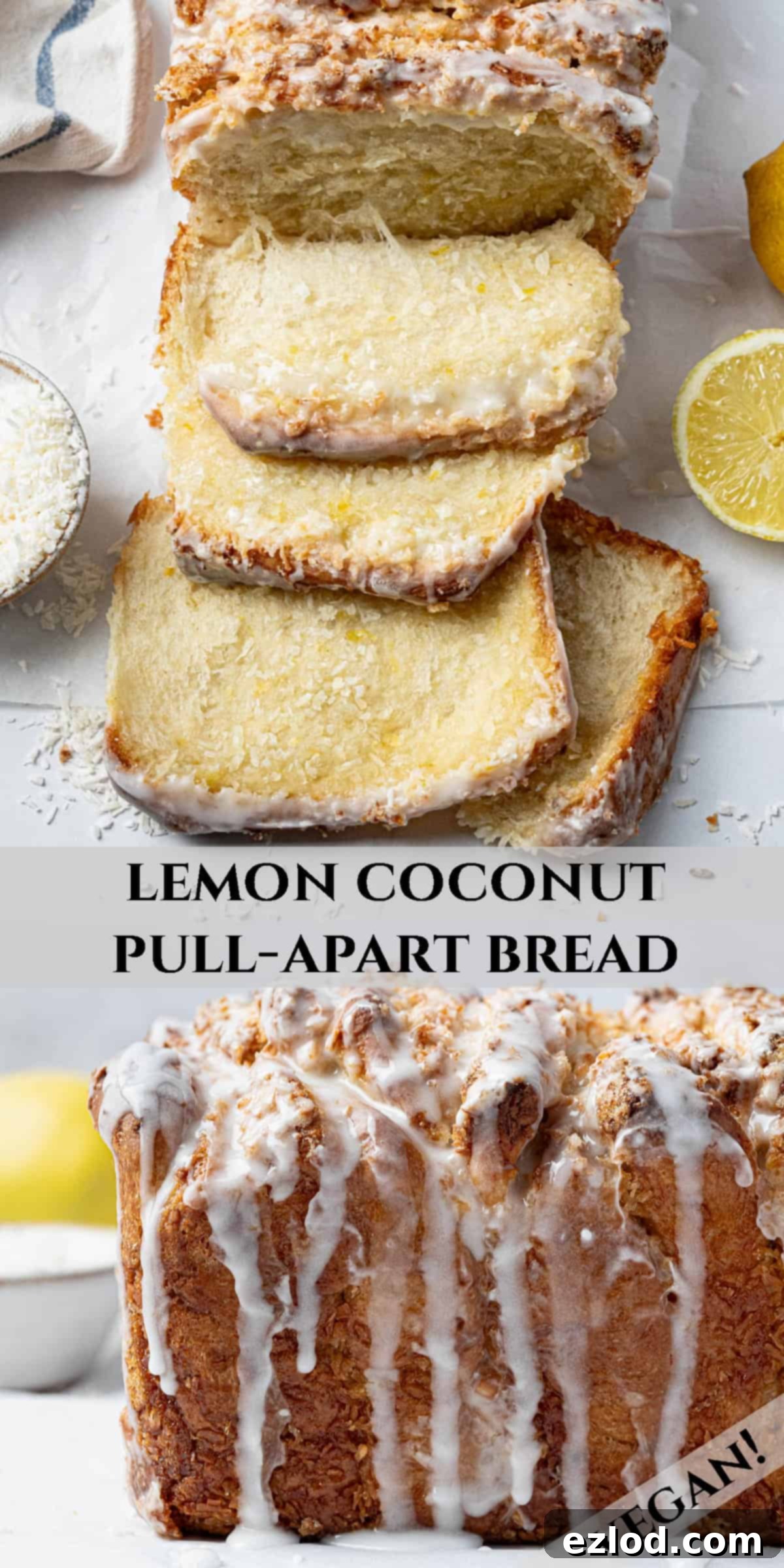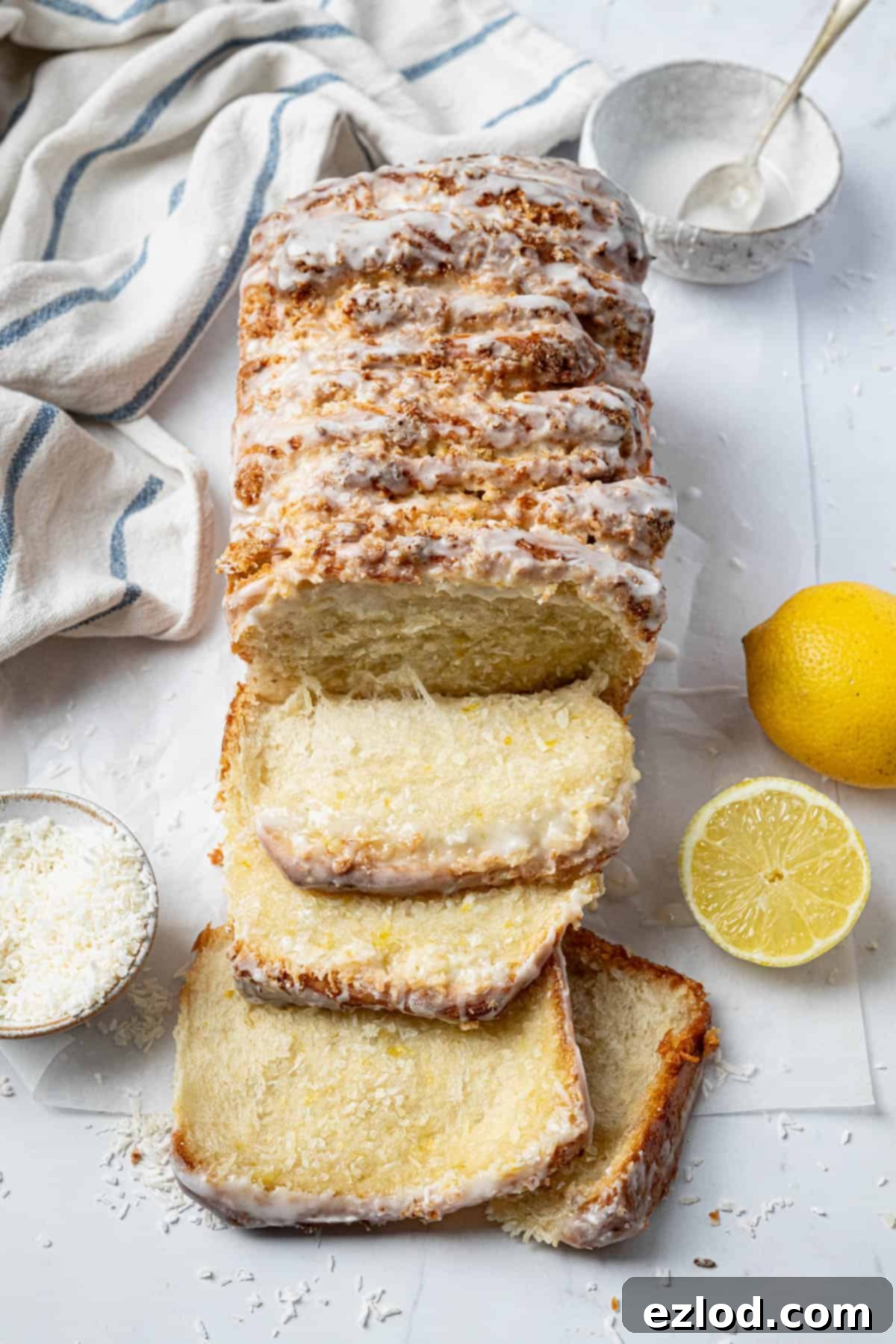Irresistible Vegan Lemon Coconut Pull-Apart Bread: Your Ultimate Sticky, Sweet & Zesty Loaf Recipe
Prepare to fall in love with this truly irresistible vegan lemon coconut pull-apart bread. It’s the ultimate share-and-tear loaf, designed for joyous gatherings and indulgent mornings. Picture a beautifully golden, incredibly soft, and delightfully sticky bread, bursting with the bright, fresh, and summery flavors of zingy lemon and tropical coconut. This isn’t just a bread; it’s an experience, a delightful fusion of citrus and tropical sweetness that will transport your taste buds to a sun-drenched paradise with every tender bite.
Perfectly suited for a special breakfast, a leisurely brunch, or even an afternoon treat, this bread requires no slicing. Simply serve it warm, and let everyone revel in the simple pleasure of tearing off their own piece. The communal act of sharing this fragrant loaf makes it even more enjoyable, though be warned – it’s notoriously difficult to stop once you start!
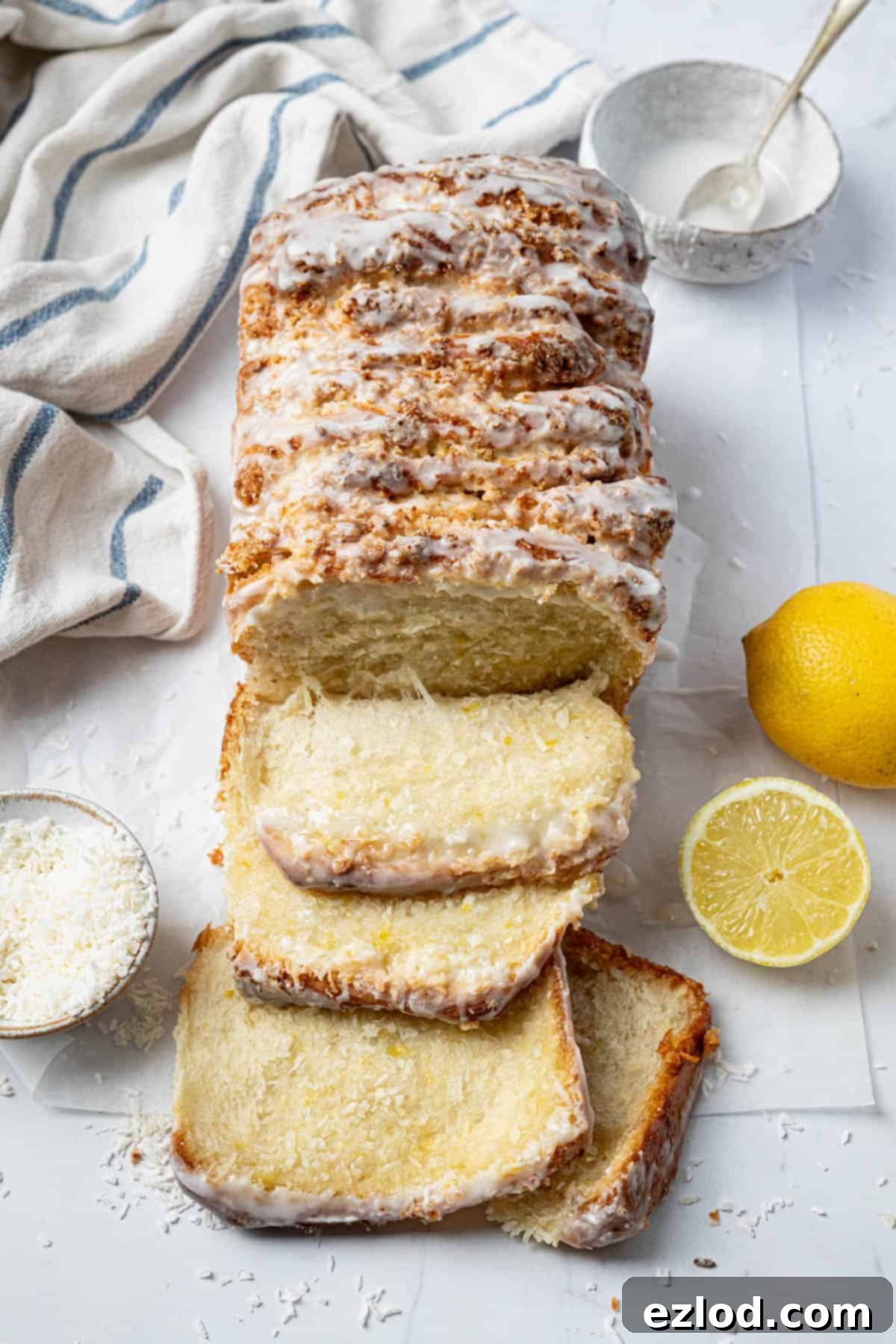
This particular recipe is a proud update and veganized version of one of my cherished old recipes, and I can confidently say it’s a real triumph! We’ve incorporated full-fat coconut milk directly into the dough, which works wonders to create an unbelievably soft and tender crumb, while also imparting a delicate yet distinct coconut flavor that permeates every strand. The filling is a delectable combination of rich vegan butter, granulated sugar, finely grated lemon zest for that essential citrus punch, and unsweetened desiccated coconut.
But the indulgence doesn’t stop there. To crown this magnificent loaf, I’ve added a vibrant, zingy glaze. This luminous topping is crafted from a simple yet effective blend of icing sugar, freshly squeezed lemon juice, and a touch more coconut milk, tying all the flavors together beautifully. As the bread bakes, the butter and sugar in the filling melt and caramelize, creating wonderfully crunchy, golden-brown edges, while the center remains incredibly soft and luscious. The aroma that fills your kitchen while this bread is baking is nothing short of heavenly – a fragrant symphony of bright lemon, sweet coconut, and freshly baked yeasty bread. It truly is a sensory delight from start to finish!

Key Ingredient Details for Perfect Vegan Lemon Coconut Pull-Apart Bread
Understanding the role of each ingredient is crucial for achieving the perfect texture and flavor in your lemon coconut pull-apart bread. Here’s a closer look at what you’ll need and why:
Coconut: For the dough, you’ll need full-fat tinned coconut milk. This provides richness and helps create that wonderfully soft, tender crumb, along with a subtle coconut essence. While light coconut milk can be used in a pinch, it may result in a slightly less rich dough. Please avoid using coconut drinking milk, as its thinner consistency is not suitable for this recipe. For the filling, unsweetened desiccated coconut is essential. Sweetened varieties would make the final loaf overly sugary, overpowering the delicate balance of flavors we aim for.
Lemons: Fresh lemons are the star here! We use finely grated lemon zest generously, as it’s where the majority of the bright, fresh, and essential lemony flavor resides. You’ll need approximately four lemons in total for both the dough, filling, and glaze. Always ensure they are unwaxed, especially when using the zest, as wax can leave an unpleasant residue and affect the flavor. The juice will be primarily for the zingy glaze, offering a delightful tart counterpoint to the sweetness.
Bread Flour: White bread flour is my top recommendation because its higher protein content develops gluten, which is key to achieving that soft, fluffy, and delightfully chewy texture we want in a pull-apart bread. While plain (all-purpose) flour can be used, be aware that the final texture may be slightly less elastic and more cake-like. I strongly advise against using wholemeal flour, as its coarser texture and lower gluten development will likely result in a much denser, heavier bread.
Instant/Fast Action Yeast: I consistently opt for fast-action yeast when baking bread. Its convenience is unmatched, as it can be added directly to the dry ingredients without needing to be activated in liquid first. This saves time and simplifies the process. Always double-check the expiry date of your yeast; old or inactive yeast is the most common reason for bread failing to rise.
Salt: Never underestimate the power of salt in bread making! It’s not just for flavor; salt also plays a vital role in regulating yeast activity and strengthening the gluten structure. Omitting it will result in a bland, potentially over-risen, and poorly textured loaf. Use a good quality fine sea salt for the best results.
Vegan Butter: For the filling, a good quality vegan butter is crucial. While I often recommend block butter for baking for structural integrity, for this particular recipe, a tub variety (as long as it’s not a low-fat spread) works perfectly fine, especially for spreading. I’ve had great success with brands like Flora Original, but any reliable vegan butter substitute with a good fat content will do the trick.
Sugar: Both caster or granulated sugar will work beautifully in this recipe, providing sweetness and contributing to the golden-brown crust. I don’t recommend swapping this for liquid sweeteners or sugar alternatives, as they can significantly alter the dough’s texture and behavior. Additionally, you will need icing (powdered) sugar for preparing the luscious and vibrant glaze.
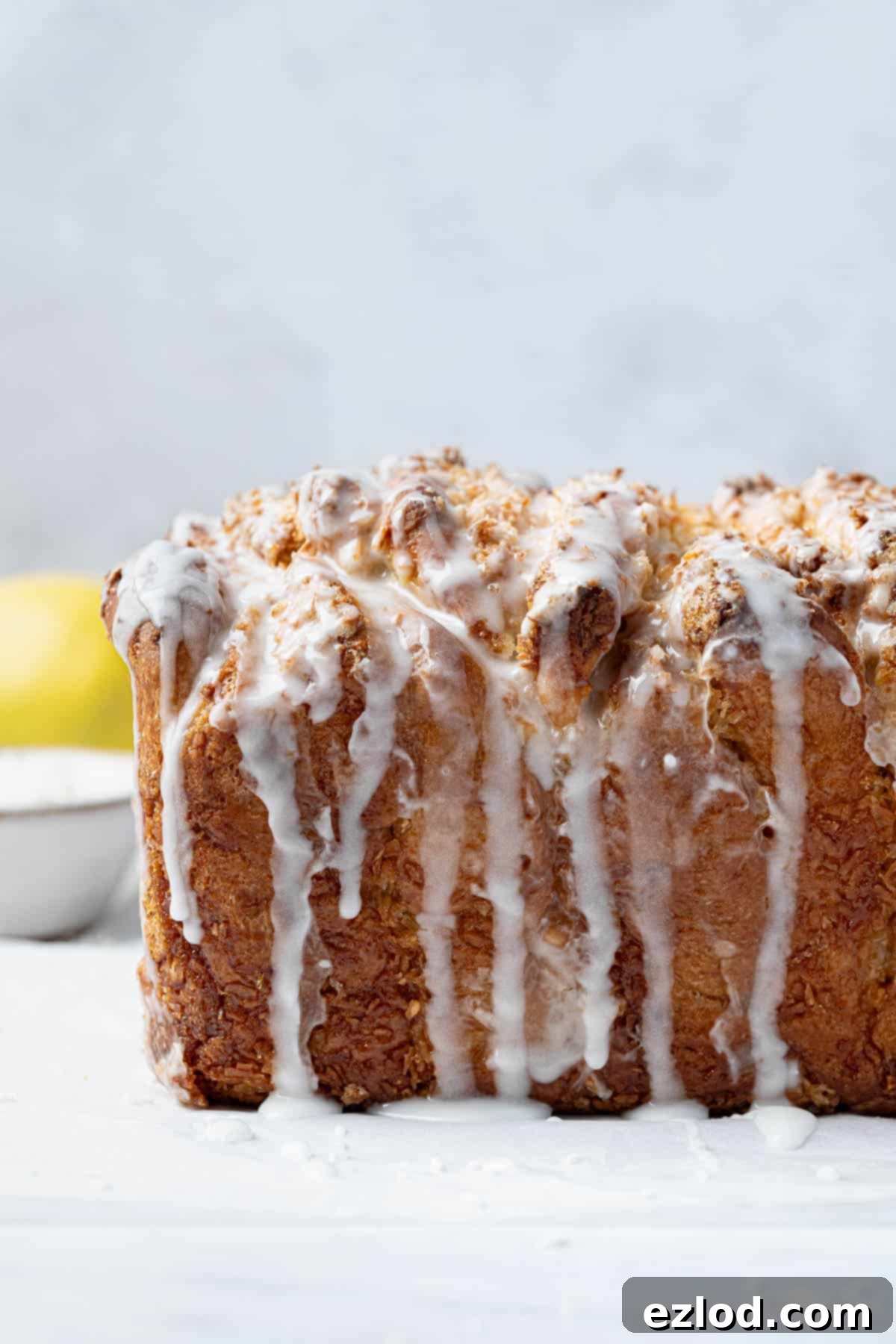
How To Make This Delicious Vegan Lemon Coconut Pull-Apart Bread: A Step-by-Step Guide
(For precise measurements and complete instructions, please refer to the detailed recipe card conveniently located at the bottom of this page.)
Step 1: In a large mixing bowl, combine the bread flour, sugar, instant yeast, salt, and the finely grated zest from one lemon. These dry ingredients form the foundation of our flavorful dough. Pour in the full-fat coconut milk and stir everything together with a sturdy spoon or spatula until a shaggy, rough dough begins to form. Add a small splash of water, if necessary, to ensure all the flour is fully incorporated and no dry spots remain.

Step 2: Turn the rough dough out onto a clean, unfloured work surface. Begin kneading for approximately 10 minutes. During this crucial stage, the dough will transform, gradually becoming smooth, pliable, and wonderfully elastic. Don’t be discouraged if it feels a bit sticky at first; patience is key, and it will come together beautifully.
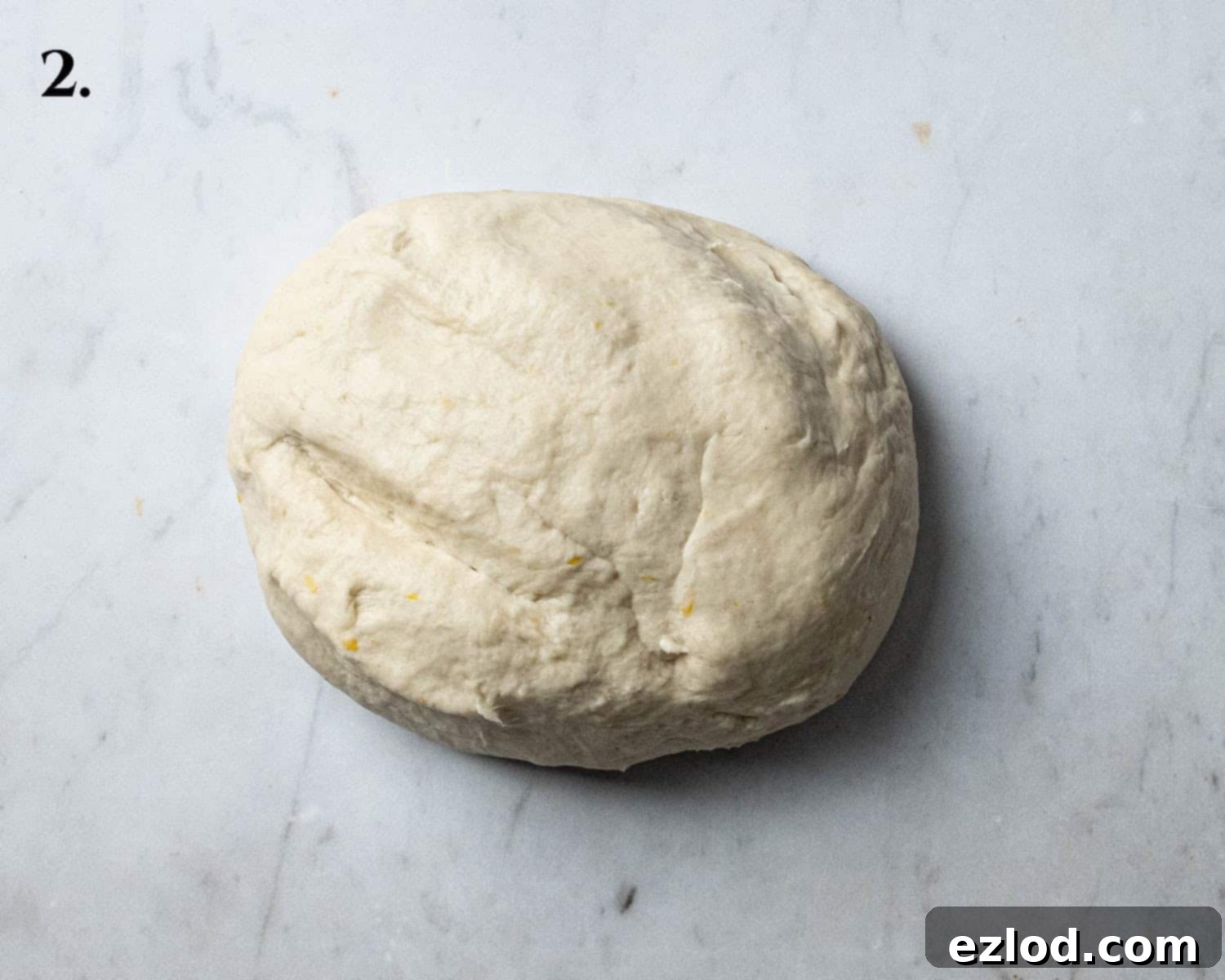
Step 3: Now, it’s time to incorporate the softened vegan butter into the dough. This step might get a little messy initially, as the butter will seem to resist blending. Continue kneading diligently until the butter is completely combined into the dough and it returns to a smooth, stretchy, and slightly tacky texture. Resist the urge to add more flour here, as it will make the final bread dense. The dough should still be soft and manageable.
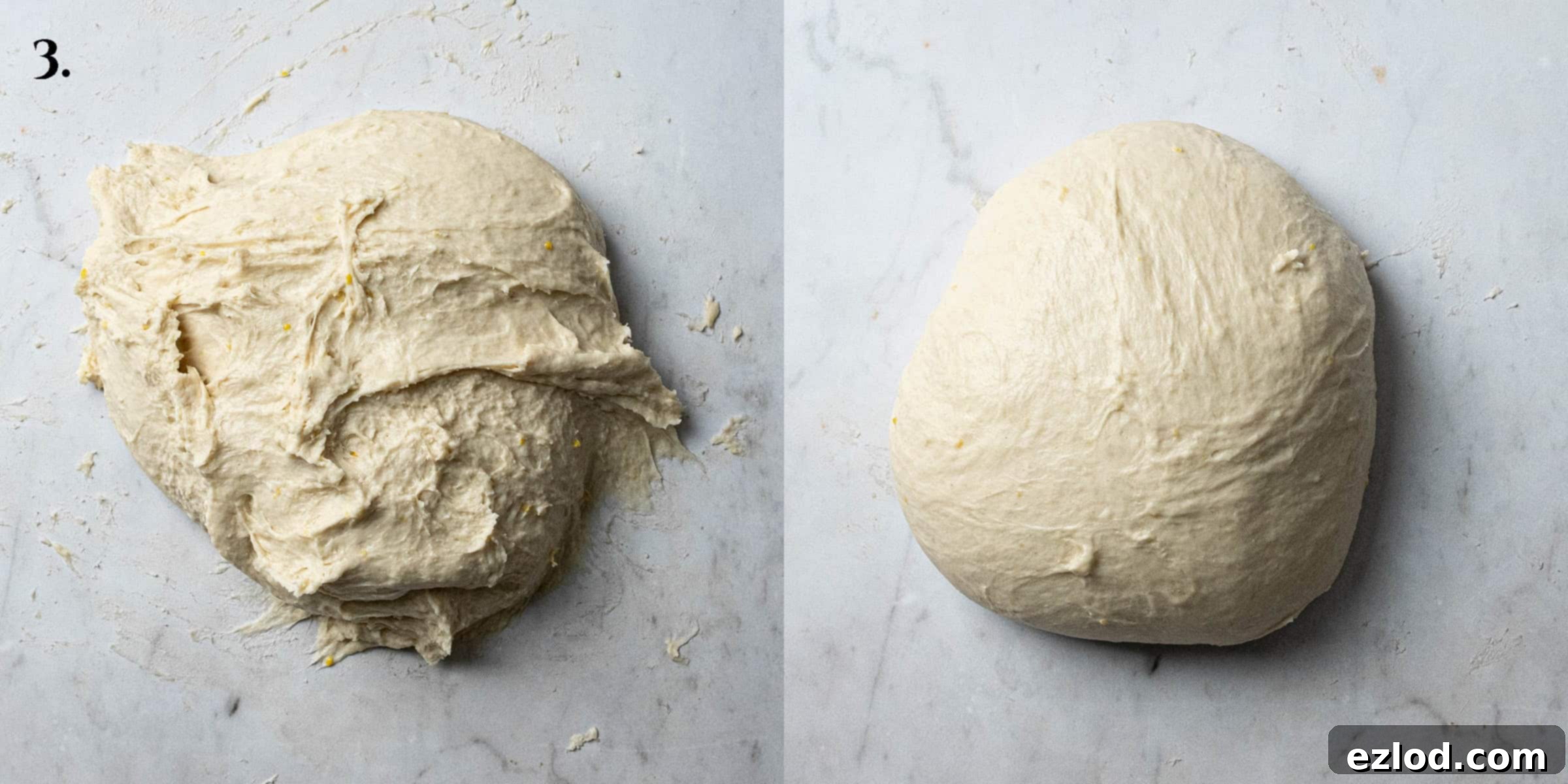
Step 4: Gently transfer the kneaded dough into a lightly greased bowl. Cover the bowl tightly with a clean kitchen towel or plastic wrap to prevent it from drying out. Place it in a warm, draft-free spot and allow it to rise until it has visibly doubled in size. This process typically takes about an hour, but can vary depending on your room temperature.
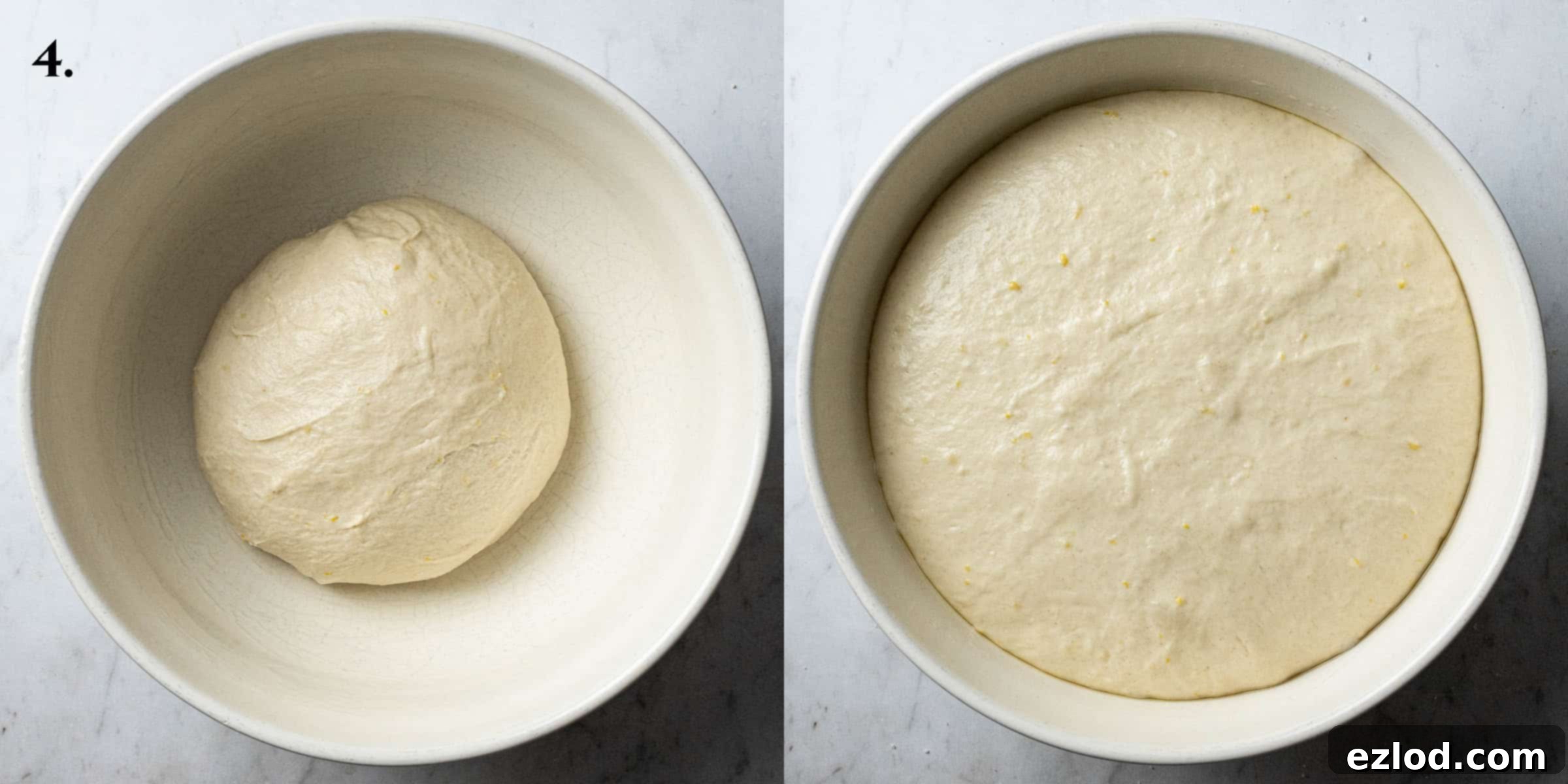
Step 5: While the dough is undergoing its first rise, prepare the sensational filling. In a medium bowl, combine the granulated sugar and the finely grated zest of the remaining three lemons. Use your fingertips to rub the lemon zest vigorously into the sugar. This action releases the essential oils from the zest, infusing the sugar with an intense lemon aroma and flavor. Finally, stir in the unsweetened desiccated coconut until well combined.
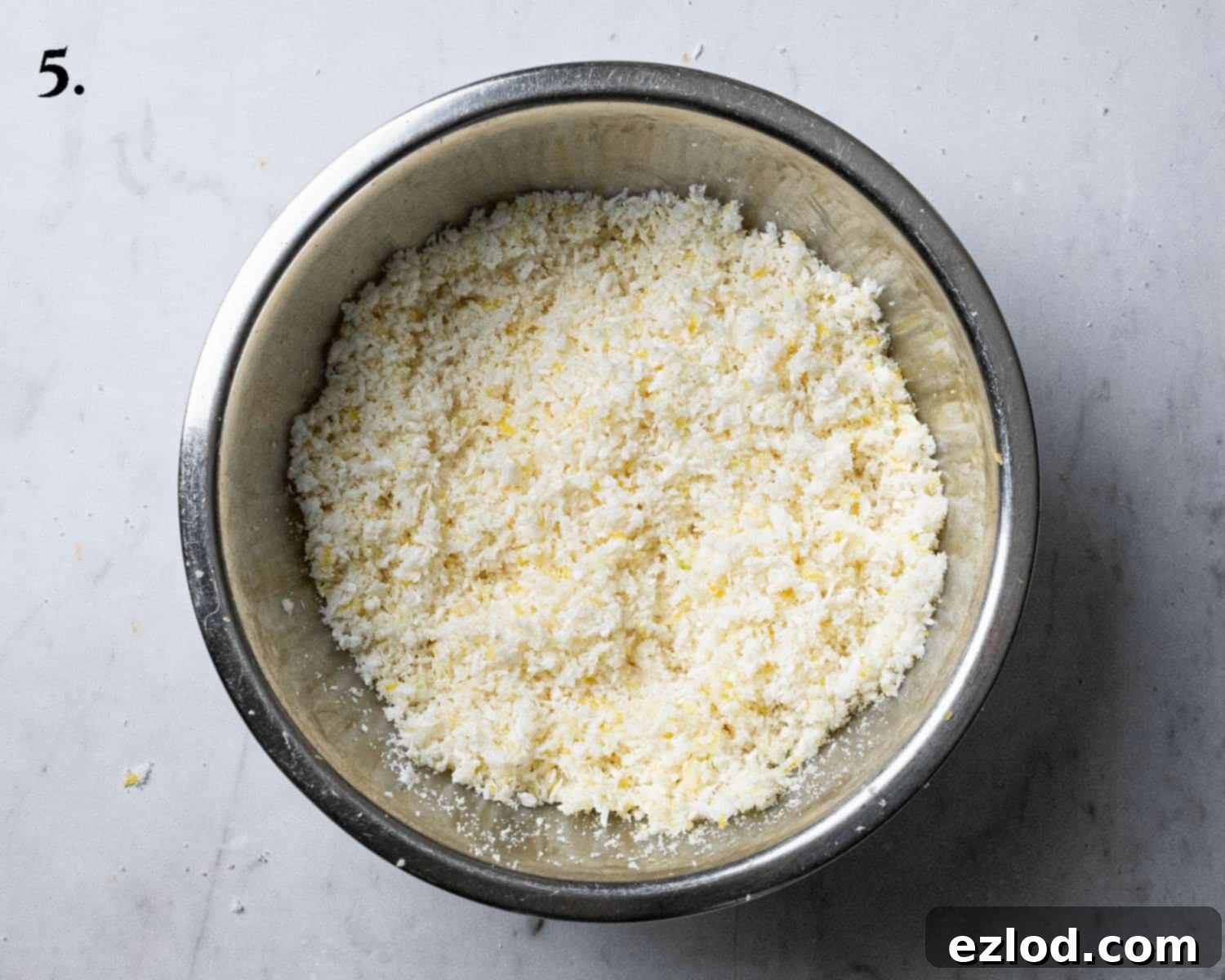
Step 6: Once the dough has doubled, gently punch it down to release the air. On a lightly floured surface, roll the dough out into a large rectangle, approximately 30 x 45 cm (12 x 18 inches). Ensure an even thickness. Next, take the very soft vegan butter for the filling and spread it evenly across the entire surface of the rolled-out dough, right to the edges. This butter layer will create a wonderfully rich and sticky base for our filling.
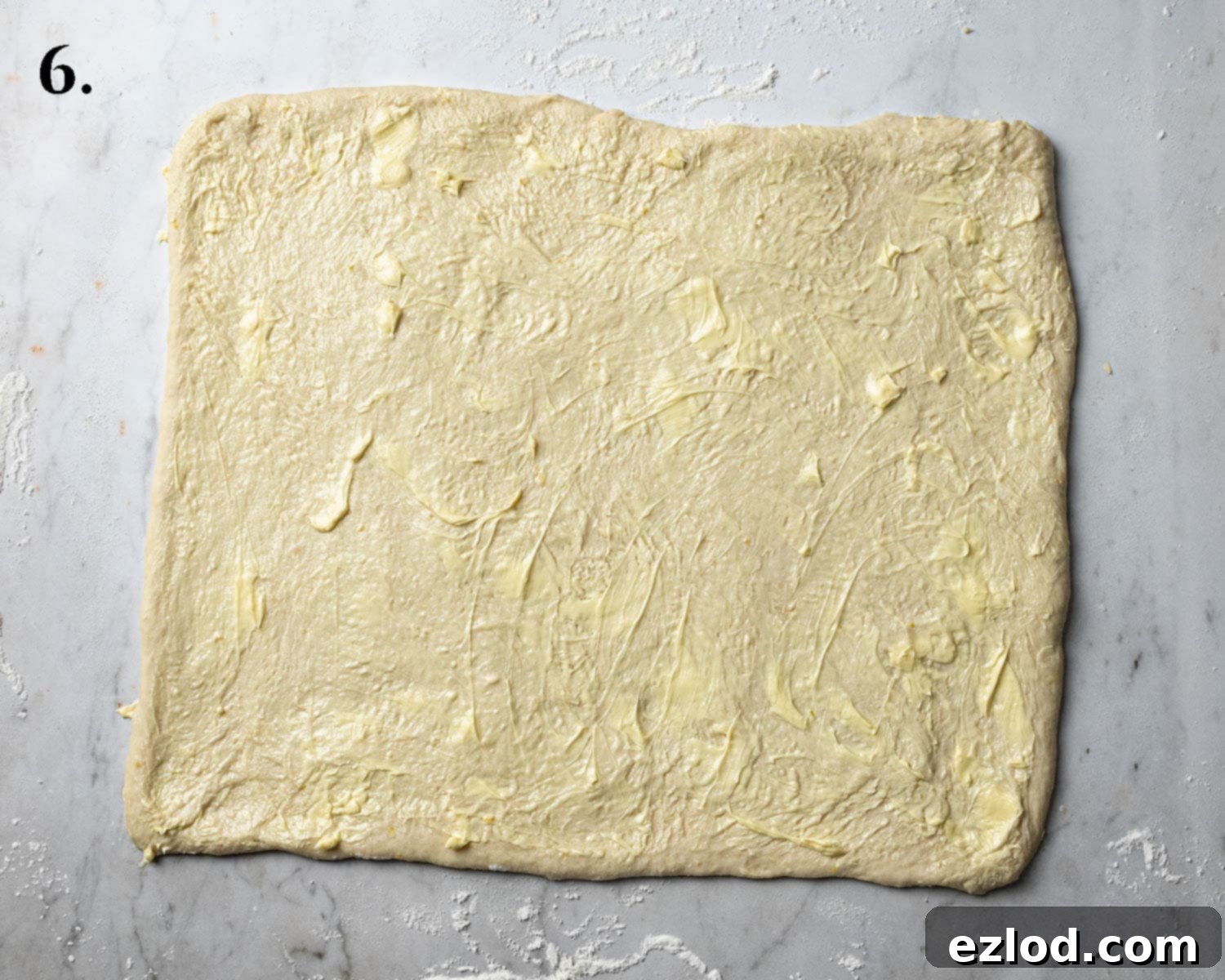
Step 7: Generously sprinkle the prepared lemon-coconut sugar mixture evenly over the butter-coated dough. Use your hands to gently pat it down, ensuring it adheres well to the butter. Now, using a pizza wheel or a sharp knife, carefully cut the dough rectangle width-wise into 5 even strips, and then lengthwise into 4 strips. This will create a total of 20 uniform squares of dough, each coated with our delicious filling.
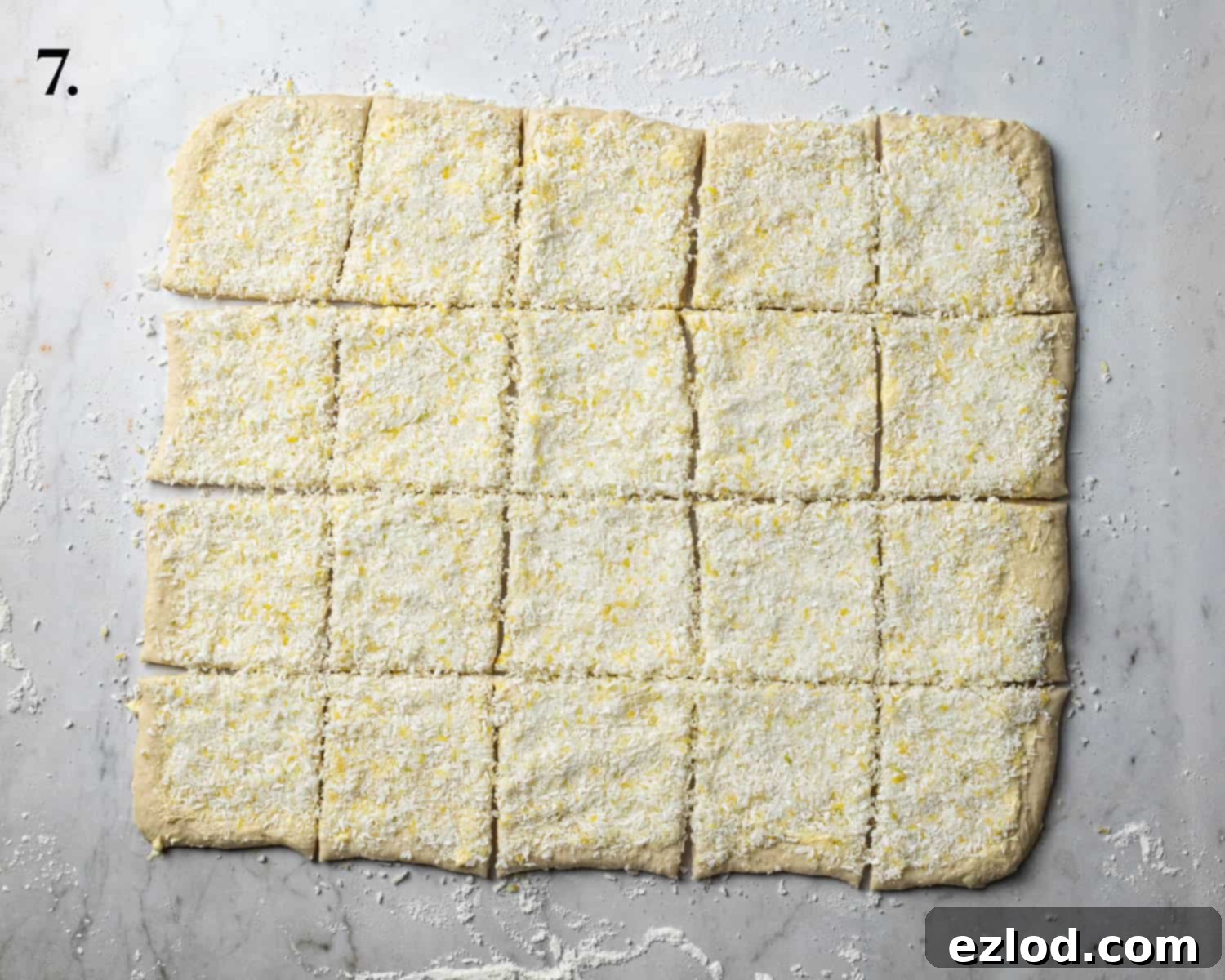
Step 8: Carefully stack the individual dough squares into 5 neat piles, ensuring each pile contains 4 squares. Try to keep the filling side facing outwards or evenly distributed for the best pull-apart effect. Line a 2 lb loaf tin with parchment paper, allowing some overhang for easy removal later.

Step 9: Arrange these dough piles upright in the prepared loaf tin, fitting them snugly together. Don’t worry if a little filling falls off; simply gather any stray coconut mixture and scatter it over the top of the stacked dough. Loosely cover the tin with plastic wrap or a kitchen towel and let it rise again in a warm place for about 45 minutes, or until the loaf appears visibly puffy and well-risen.
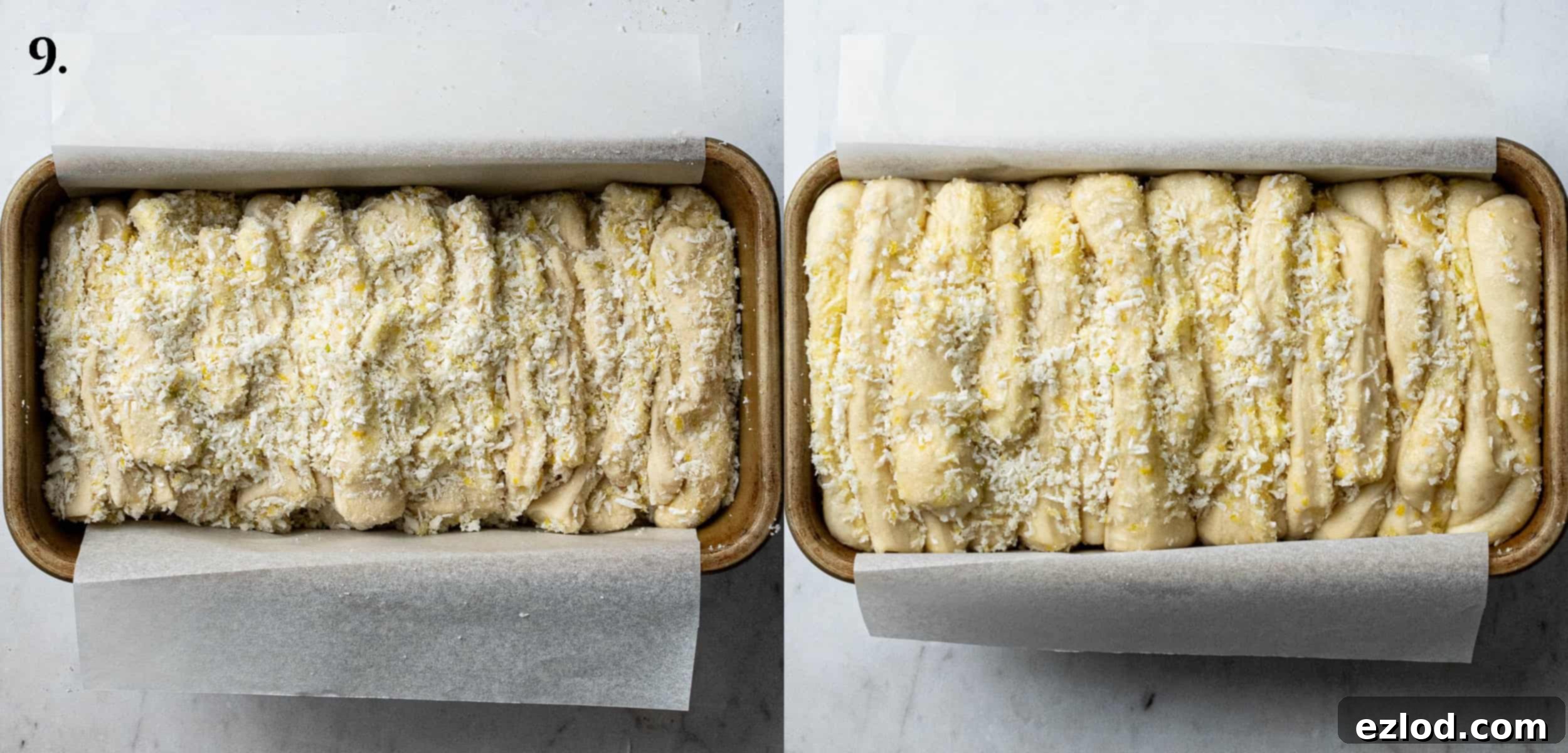
Step 10: Preheat your oven to 190°C/170°C fan/375°F/gas mark 5 while the bread undergoes its final rise. Once preheated and the bread is puffy, bake for approximately 45 minutes. The bread should be beautifully golden brown on top and cooked through. For absolute certainty, a probe thermometer inserted into the center should read at least 90°C/194°F. Alternatively, a skewer inserted into the center should come out clean with no raw dough attached. Allow to cool slightly in the tin before glazing.

Expert Top Tips for Baking Perfect Pull-Apart Bread
Achieving a bakery-quality pull-apart bread at home is incredibly rewarding. Follow these expert tips to ensure your vegan lemon coconut loaf turns out perfectly every time:
Precision with Measurements: As with all my baking recipes, I wholeheartedly recommend utilizing metric measurements and a digital kitchen scale over imprecise cup conversions. Cups are notoriously inaccurate and can lead to inconsistent results. A scale offers far better precision, leading to more reliable and delicious outcomes, plus it often makes for a less messy process!
Check Your Yeast: The vitality of your yeast is paramount. Always verify that your instant/fast-action yeast is well within its expiry date. Old or inactive yeast is the primary culprit behind doughs that fail to rise, leading to dense and disappointing bread.
Patience with Rising Time: Dough rising times are not absolute; they are highly dependent on the ambient temperature. On warmer days, your dough will prove much faster than on cooler ones. Find a warm, draft-free spot, and keep an eye on the dough rather than strictly adhering to a timer. It’s ready when it has doubled in size, not necessarily at a specific minute mark.
Overnight Rise for Enhanced Flavor: For an even deeper, more complex flavor and added convenience, consider giving your dough its first rise overnight in the refrigerator. The slow, cold fermentation develops more nuanced flavors and can make the dough even easier to handle. This also helps break up the workload, making baking day less rushed.
Serving and Storage: While this lemon coconut pull-apart bread is truly at its absolute best eaten warm and fresh from the oven, it remains wonderfully soft and delicious the following day. To revive its fresh-baked texture and warmth, simply pop a slice or a piece into the microwave for 20-30 seconds, or warm it gently in a low oven.
Flavor Variations: Don’t be afraid to experiment with the citrus! You can easily swap the lemon zest for an equal amount of finely grated orange zest or lime zest to create a delightful new flavor profile. Consider adding a hint of vanilla extract to the dough or glaze for another layer of sweetness.
Lining the Tin: Always line your loaf tin with baking parchment paper, allowing some overhang on the longer sides. This not only prevents sticking but also makes it incredibly easy to lift the entire loaf out of the tin once baked, preserving its beautiful shape.
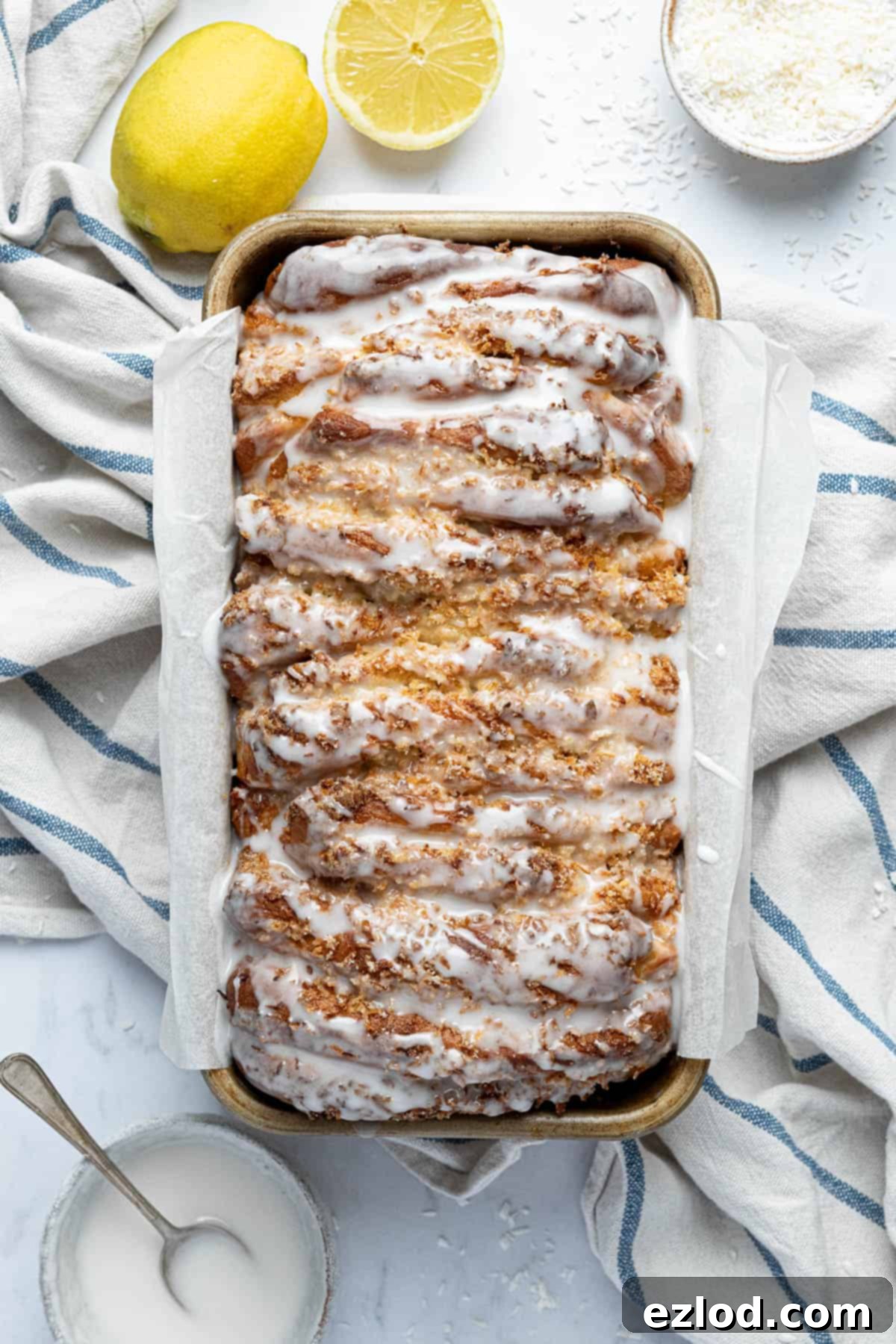
Frequently Asked Questions About Vegan Lemon Coconut Pull-Apart Bread
To maintain its delightful softness and flavor, store your lemon coconut pull-apart bread in an airtight container at room temperature. It will remain delicious for up to 2 days. Keeping it well-sealed prevents it from drying out and helps preserve its sticky, sweet qualities.
Absolutely, this bread freezes beautifully! Once the baked lemon coconut bread has cooled completely, it can be frozen. For optimal freshness, I recommend freezing it on the very day it is baked. Ensure it’s stored in an airtight container or tightly wrapped in multiple layers of plastic wrap and then foil to protect it from freezer burn. To serve, allow it to defrost at room temperature, then refresh it in a low oven (around 150°C/300°F) for about 10 minutes, or a quick 20-30 seconds in the microwave, just until warmed through. I do not recommend freezing the unbaked dough, as the yeast activity can be unpredictable after thawing.
While this dough is intentionally soft and a bit sticky to ensure a tender final product, making it easiest to handle in a stand mixer, you can absolutely knead it by hand! Just be prepared to get a little messy and embrace the stickiness. When kneading by hand, it’s crucial *not* to add extra flour to your work surface or hands, as this will result in a dry, dense dough. Instead, if the dough is sticking excessively, lightly oil your hands and the work surface. A bench scraper will be your best friend, helping you to gather and unstick the dough from the surface efficiently during the kneading process.
The most reliable method to ascertain if bread is properly baked is by checking its internal temperature with a probe thermometer. Insert it into the center of the loaf; it should reach at least 90°C (194°F). If you don’t have a probe thermometer, look for visual cues: the lemon coconut bread should be beautifully risen, deeply golden brown, and feel firm to the touch. A skewer inserted into the center should slide in and out smoothly with minimal resistance and emerge completely clean, without any wet dough clinging to it.
Unfortunately, no, this recipe is not designed to be made with gluten-free flour. Creating successful gluten-free bread requires a completely different approach to ingredients and ratios, as gluten plays a fundamental role in the structure and texture of this specific type of bread. Gluten-free baking is a specialized area, and it’s best to follow recipes that are specifically developed for gluten-free ingredients rather than attempting to adapt a traditional wheat-based recipe. Doing so would likely yield very unsatisfactory results.
Discover More Delicious Vegan Sweet Bread Recipes:
- Vegan banana monkey bread
- Jamaican spice bun
- Mocha cinnamon rolls
- Rhubarb frangipane buns
- Banana bread cinnamon rolls
- Chocolate chip pumpkin rolls
- Vegan cinnamon rolls
- Vegan Belgian buns
- Vegan chocolate babka
- Vegan pumpkin pecan babka
- Maple pecan bread wreath
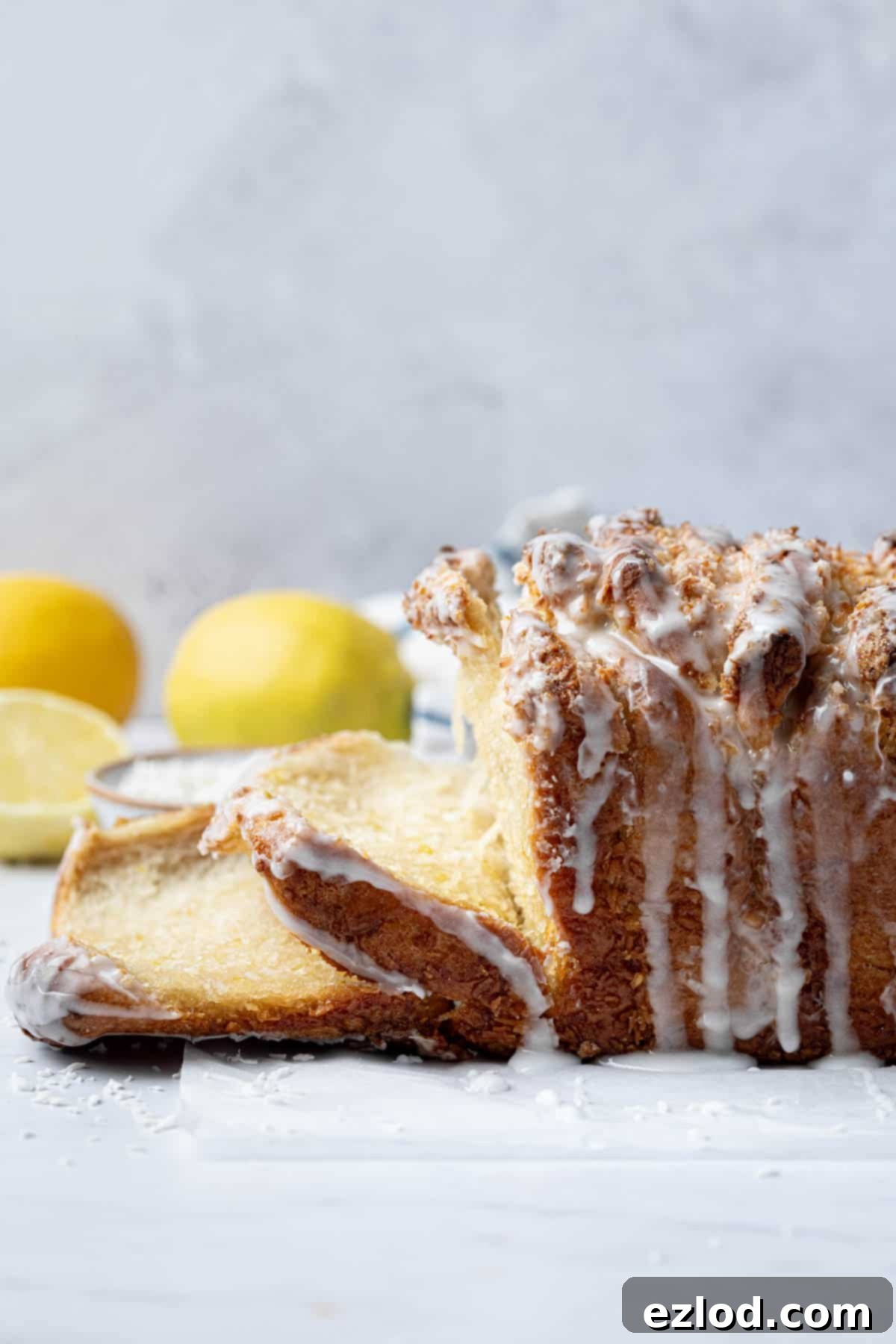
If you’ve had the pleasure of trying this delightful recipe, I’d love to hear from you! Please take a moment to rate it, leave a comment below, or share your creation on Instagram by tagging @domestic_gothess and using the hashtag #domesticgothess. Your feedback and photos truly make my day!
Please note that all images and content found on Domestic Gothess are protected by copyright. If you wish to share this recipe, kindly do so by utilizing the provided share buttons. We respectfully request that you do not screenshot or post the recipe or its content in full. Instead, please include a direct link back to this post for the complete recipe. Thank you for your understanding and support!

Lemon Coconut Pull-Apart Bread (Vegan)
Ingredients
For the Dough
- 400 g (3 + ⅓ cups) white bread flour
- 7 g (2 teaspoons) fast action yeast
- 40 g (3 Tablespoons) caster or granulated sugar
- 1 teaspoon salt
- 250 g ( 1 cup) full fat coconut milk
- finely grated zest of 1 lemon
- splash of water as needed
- 40 g (3 Tablespoons) vegan butter softened
For the Filling
- 125 g (⅔ cup) caster or granulated sugar
- finely grated zest of 3 lemons
- 60 g (packed ¼ cup) unsweetened desiccated coconut
- 40 g (3 Tablespoons) vegan butter very soft
For the Glaze
- 80 g (¾ cup) icing (powdered) sugar
- 1 Tablespoon coconut milk
- 1-2 teaspoons lemon juice
Instructions
-
In a large bowl, place the bread flour. Add the yeast to one side of the bowl and the sugar and salt to the other, keeping them separate initially. Stir in the coconut milk and the zest of 1 lemon until a shaggy dough forms. Add a small splash of water as needed until all the flour is fully incorporated.
-
Turn the dough out onto an unfloured work surface. Knead for approximately 10 minutes until the dough becomes smooth, elastic, and less sticky. (A stand mixer with a dough hook can accomplish this in about 7-8 minutes).
-
Incorporate the softened vegan butter by kneading it into the dough. It will be messy at first, but continue kneading until the butter is fully absorbed and the dough is smooth and stretchy again. The dough should remain fairly soft and slightly tacky; resist the urge to add more flour.
-
Transfer the dough to a lightly greased bowl, cover it with plastic wrap or a damp cloth, and place it in a warm, draft-free spot. Let it rise for about 1 hour, or until it has doubled in size.
-
While the dough rises, prepare your 2 lb loaf tin by lining it with greaseproof paper, leaving an overhang. For the filling, combine the sugar and the zest of 3 lemons in a bowl. Rub the zest into the sugar with your fingertips to release the fragrant oils, then stir in the unsweetened desiccated coconut.
-
On a lightly floured surface, roll the risen dough out into a rectangle approximately 30 x 45 cm (12 x 18 inches). Spread the very soft vegan butter evenly over the entire surface of the dough. Then, sprinkle the lemon-coconut sugar mixture over the butter and gently press it down to adhere.
-
Using a pizza cutter or a sharp knife, slice the dough widthways into 5 even strips, then lengthwise into 4 strips, creating 20 uniform squares of dough. Stack these squares into 5 piles, with 4 squares in each pile.
-
Arrange the stacked dough piles upright in the prepared loaf tin, nestling them closely together to fit. Gather any coconut filling that may have fallen off and scatter it over the top of the loaf. Loosely cover the tin and allow it to rise in a warm place for about 45 minutes, or until the loaf looks noticeably puffy.
-
Meanwhile, preheat your oven to 190°C (170°C fan/375°F/gas mark 5).
-
Bake for approximately 45 minutes. The bread is baked through when a probe thermometer inserted into the center registers at least 90°C (194°F), or a skewer inserted comes out clean with no raw dough.
-
Once baked, allow the bread to cool in the tin on a wire rack for 10 minutes.
-
While the bread is cooling slightly, prepare the glaze. Sift the icing (powdered) sugar into a small bowl. Stir in the coconut milk and 1-2 teaspoons of lemon juice until you achieve a smooth, pourable consistency. Add a little more lemon juice if the glaze is too thick, or a touch more icing sugar if it’s too thin.
-
Carefully turn the bread out onto a serving dish, remove the parchment paper, and generously pour the prepared glaze over the warm loaf. Serve immediately and enjoy!
Notes
- For additional helpful tips, detailed insights, and step-by-step photos that complement this recipe, please refer to the main content above. Many common questions might already be addressed there!
- To ensure the most accurate and consistent results in all your baking endeavors, I highly recommend using metric measurements with a digital kitchen scale instead of volume-based cup conversions. This method is far more precise, leading to better outcomes and often a cleaner, more efficient baking experience.
